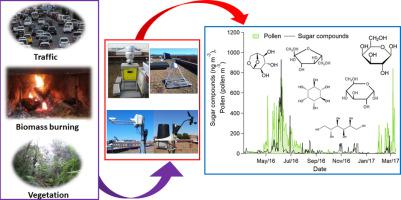当前位置:
X-MOL 学术
›
Atmos. Res.
›
论文详情
Our official English website, www.x-mol.net, welcomes your feedback! (Note: you will need to create a separate account there.)
One-year study of airborne sugar compounds: Cross-interpretation with other chemical species and meteorological conditions
Atmospheric Research ( IF 5.5 ) Pub Date : 2021-04-01 , DOI: 10.1016/j.atmosres.2020.105417 F. Oduber , A.I. Calvo , A. Castro , C. Alves , C. Blanco-Alegre , D. Fernández-González , J. Barata , G. Calzolai , S. Nava , F. Lucarelli , T. Nunes , A. Rodríguez , A.M. Vega-Maray , R.M. Valencia-Barrera , R. Fraile
Atmospheric Research ( IF 5.5 ) Pub Date : 2021-04-01 , DOI: 10.1016/j.atmosres.2020.105417 F. Oduber , A.I. Calvo , A. Castro , C. Alves , C. Blanco-Alegre , D. Fernández-González , J. Barata , G. Calzolai , S. Nava , F. Lucarelli , T. Nunes , A. Rodríguez , A.M. Vega-Maray , R.M. Valencia-Barrera , R. Fraile

|
Abstract The daily evolution of seventeen sugar compounds (seven saccharides, seven alcohol-saccharides and three anhydrosaccharides) in atmospheric aerosol samples collected between 9 March 2016 and 14 March 2017 was studied in Leon (Spain). The main links between the concentration of sugar compounds and various chemical species, pollen, fungal spores and meteorological conditions were studied. The results showed that in spring, when high levels of metabolic activity of the plants occur and temperatures increase, glucose, sucrose, 2-methyl-erithritol, mannitol, arabitol and inositol, are significantly correlated with airborne pollen concentration. Between spring and autumn, Alternaria air concentrations is significantly correlated with temperatures, arabitol and sorbitol + adonitol concentrations. Furthermore, during rainy days, Alternaria is also correlated with mannitol. In autumn, lower temperatures cause an increase in the concentrations of levoglucosan, mannosan and galactosan, probably due to the increased use of domestic heating devices. These anhydrosugars and arabinose, fructose and glucose, are significantly correlated with K, NO3−, EC, OC, Cu, Zn, Se, Pb, V and Ni, while mannosan also correlates with As, showing that these anhydrosaccharides can be emitted from different anthropogenic sources. Precipitation causes an increase in glucose and sucrose concentrations, due to the break of pollen particles that produce hundreds of fine size particles. Besides, precipitation causes an increase in arabitol concentration, due to the release and growth of fungi.
中文翻译:

空气中糖化合物的一年研究:与其他化学物种和气象条件的交叉解释
摘要 在莱昂(西班牙)研究了 2016 年 3 月 9 日至 2017 年 3 月 14 日期间收集的大气气溶胶样品中 17 种糖类化合物(7 种糖类、7 种醇糖类和 3 种脱水糖类)的日常演变。研究了糖化合物浓度与各种化学物质、花粉、真菌孢子和气象条件之间的主要联系。结果表明,在春季,当植物发生高水平的代谢活动和温度升高时,葡萄糖、蔗糖、2-甲基赤藓糖醇、甘露醇、阿拉伯糖醇和肌醇与空气中花粉浓度显着相关。在春季和秋季之间,链格孢空气浓度与温度、阿拉伯糖醇和山梨糖醇 + 阿东糖醇浓度显着相关。此外,在下雨天,链格孢也与甘露醇有关。在秋季,较低的温度会导致左旋葡聚糖、甘露聚糖和半乳糖的浓度增加,这可能是由于家庭加热设备的使用增加了。这些脱水糖和阿拉伯糖、果糖和葡萄糖与 K、NO3−、EC、OC、Cu、Zn、Se、Pb、V 和 Ni 显着相关,而甘露聚糖也与 As 相关,表明这些脱水糖可以从不同的人为来源。由于产生数百个细小颗粒的花粉颗粒破裂,沉淀导致葡萄糖和蔗糖浓度增加。此外,由于真菌的释放和生长,降水会导致阿糖醇浓度增加。较低的温度会导致左旋葡聚糖、甘露聚糖和半乳糖的浓度增加,这可能是由于越来越多地使用家用加热设备。这些脱水糖和阿拉伯糖、果糖和葡萄糖与 K、NO3−、EC、OC、Cu、Zn、Se、Pb、V 和 Ni 显着相关,而甘露聚糖也与 As 相关,表明这些脱水糖可以从不同的人为来源。由于产生数百个细小颗粒的花粉颗粒破裂,沉淀导致葡萄糖和蔗糖浓度增加。此外,由于真菌的释放和生长,降水会导致阿糖醇浓度增加。较低的温度会导致左旋葡聚糖、甘露聚糖和半乳糖的浓度增加,这可能是由于越来越多地使用家用加热设备。这些脱水糖和阿拉伯糖、果糖和葡萄糖与 K、NO3−、EC、OC、Cu、Zn、Se、Pb、V 和 Ni 显着相关,而甘露聚糖也与 As 相关,表明这些脱水糖可以从不同的人为来源。由于产生数百个细小颗粒的花粉颗粒破裂,沉淀导致葡萄糖和蔗糖浓度增加。此外,由于真菌的释放和生长,降水会导致阿糖醇浓度增加。与 K、NO3-、EC、OC、Cu、Zn、Se、Pb、V 和 Ni 显着相关,而甘露聚糖也与 As 相关,表明这些脱水糖可以从不同的人为来源排放。由于产生数百个细小颗粒的花粉颗粒破裂,沉淀导致葡萄糖和蔗糖浓度增加。此外,由于真菌的释放和生长,降水会导致阿糖醇浓度增加。与 K、NO3-、EC、OC、Cu、Zn、Se、Pb、V 和 Ni 显着相关,而甘露聚糖也与 As 相关,表明这些脱水糖可以从不同的人为来源排放。由于产生数百个细小颗粒的花粉颗粒破裂,沉淀导致葡萄糖和蔗糖浓度增加。此外,由于真菌的释放和生长,降水会导致阿糖醇浓度增加。
更新日期:2021-04-01
中文翻译:

空气中糖化合物的一年研究:与其他化学物种和气象条件的交叉解释
摘要 在莱昂(西班牙)研究了 2016 年 3 月 9 日至 2017 年 3 月 14 日期间收集的大气气溶胶样品中 17 种糖类化合物(7 种糖类、7 种醇糖类和 3 种脱水糖类)的日常演变。研究了糖化合物浓度与各种化学物质、花粉、真菌孢子和气象条件之间的主要联系。结果表明,在春季,当植物发生高水平的代谢活动和温度升高时,葡萄糖、蔗糖、2-甲基赤藓糖醇、甘露醇、阿拉伯糖醇和肌醇与空气中花粉浓度显着相关。在春季和秋季之间,链格孢空气浓度与温度、阿拉伯糖醇和山梨糖醇 + 阿东糖醇浓度显着相关。此外,在下雨天,链格孢也与甘露醇有关。在秋季,较低的温度会导致左旋葡聚糖、甘露聚糖和半乳糖的浓度增加,这可能是由于家庭加热设备的使用增加了。这些脱水糖和阿拉伯糖、果糖和葡萄糖与 K、NO3−、EC、OC、Cu、Zn、Se、Pb、V 和 Ni 显着相关,而甘露聚糖也与 As 相关,表明这些脱水糖可以从不同的人为来源。由于产生数百个细小颗粒的花粉颗粒破裂,沉淀导致葡萄糖和蔗糖浓度增加。此外,由于真菌的释放和生长,降水会导致阿糖醇浓度增加。较低的温度会导致左旋葡聚糖、甘露聚糖和半乳糖的浓度增加,这可能是由于越来越多地使用家用加热设备。这些脱水糖和阿拉伯糖、果糖和葡萄糖与 K、NO3−、EC、OC、Cu、Zn、Se、Pb、V 和 Ni 显着相关,而甘露聚糖也与 As 相关,表明这些脱水糖可以从不同的人为来源。由于产生数百个细小颗粒的花粉颗粒破裂,沉淀导致葡萄糖和蔗糖浓度增加。此外,由于真菌的释放和生长,降水会导致阿糖醇浓度增加。较低的温度会导致左旋葡聚糖、甘露聚糖和半乳糖的浓度增加,这可能是由于越来越多地使用家用加热设备。这些脱水糖和阿拉伯糖、果糖和葡萄糖与 K、NO3−、EC、OC、Cu、Zn、Se、Pb、V 和 Ni 显着相关,而甘露聚糖也与 As 相关,表明这些脱水糖可以从不同的人为来源。由于产生数百个细小颗粒的花粉颗粒破裂,沉淀导致葡萄糖和蔗糖浓度增加。此外,由于真菌的释放和生长,降水会导致阿糖醇浓度增加。与 K、NO3-、EC、OC、Cu、Zn、Se、Pb、V 和 Ni 显着相关,而甘露聚糖也与 As 相关,表明这些脱水糖可以从不同的人为来源排放。由于产生数百个细小颗粒的花粉颗粒破裂,沉淀导致葡萄糖和蔗糖浓度增加。此外,由于真菌的释放和生长,降水会导致阿糖醇浓度增加。与 K、NO3-、EC、OC、Cu、Zn、Se、Pb、V 和 Ni 显着相关,而甘露聚糖也与 As 相关,表明这些脱水糖可以从不同的人为来源排放。由于产生数百个细小颗粒的花粉颗粒破裂,沉淀导致葡萄糖和蔗糖浓度增加。此外,由于真菌的释放和生长,降水会导致阿糖醇浓度增加。



























 京公网安备 11010802027423号
京公网安备 11010802027423号